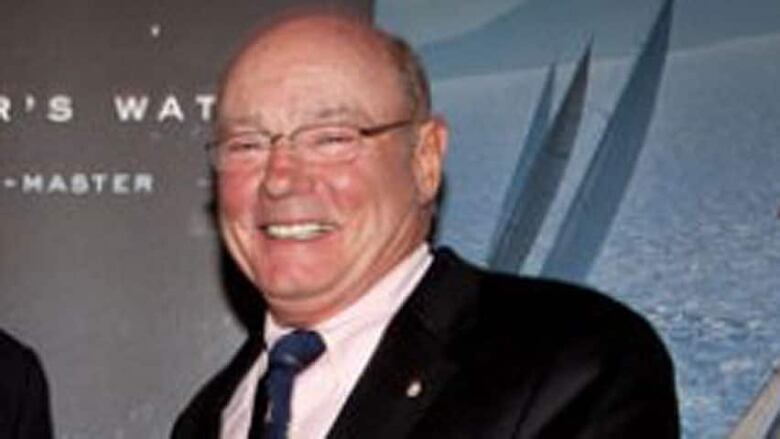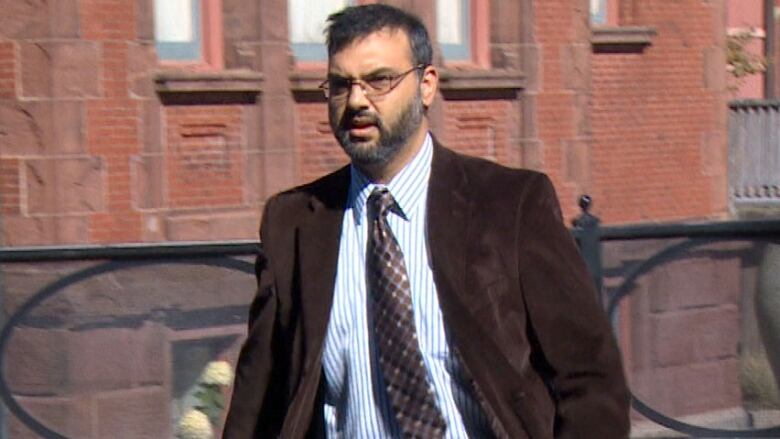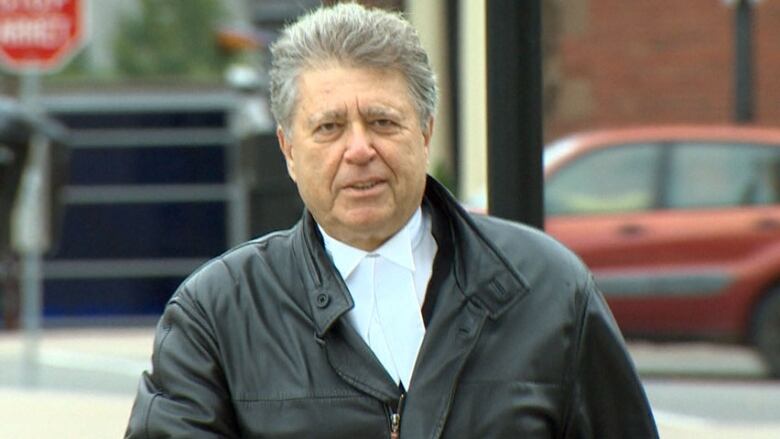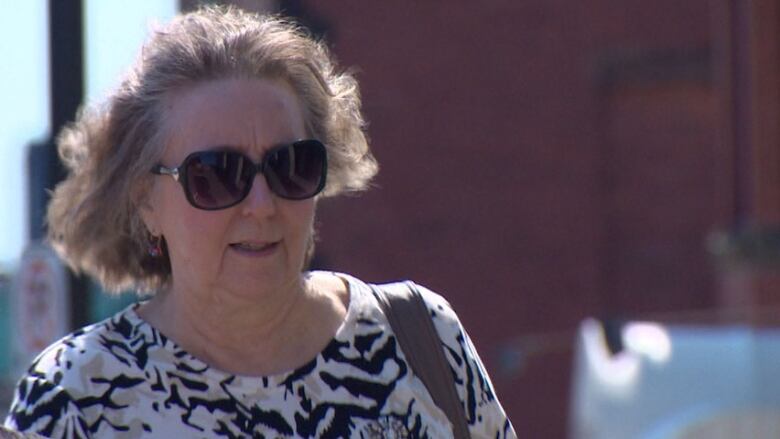Richard Oland survived only 'minutes,' murder trial hears
WARNING: This story contains graphic material that some readers may find disturbing

RichardOlandlikely survived only minutes into his vicious bludgeoning, according to the pathologist who performed the autopsy.
"In my opinion, these injuries would be rapidly fatal," Dr. Ather Naseemuddin testified Friday at Dennis Oland's second-degree murder trial in Saint John.
"Maybe 10 minutes. Maybe five," he said, although he was unable to estimate the actual time of death.
RichardOland, 69, suffered 45 sharp and blunt force injuries to his head,neck and hands, saidNaseemuddin, clarifying that he had previously reported 46, but had mistakenly counted one injury twice.
The prominent businessman's body was discovered lying facedown in a large pool of blood in his investment firmoffice on July 7, 2011.

Naseemuddin says Richard Oland's injuries were "not survivable," even if he had received prompt medical attention.
The six defensivewounds to Oland'shands were likely among the first, when he was still conscious and able to try to defend himself, said Naseemuddin.
"There are so many injurieswhich are terribly incapacitating, I would think those would have come after the victim was able to make any defensive motion."
The attack likely continued after Oland was already on the floor, defenceless, he said.
Notionof 2 perpetrators raised
During cross-examination, defencelawyer Alan Gold raised for the first time the notion of there having been two perpetrators involved.
"There must've been some initial involvement with the attacker or attackers?" he asked, referring to the defensive wounds.Naseemuddin agreed.
The doctor also agreed when Gold suggestedOlandwas "physically quite capable of defending himself," because he was a "healthy, robust man," nearly six feet tall and 192 pounds.
Friday wasNaseemuddin's second day on the stand. Hecontinued to explain Oland's injuries to the juryusing graphicphotographs taken during the lengthy autopsy, a sketch he made, as well as his notes and final post-mortem report on the July 8, 2011 procedure.
There were about 35sharp force injuries to his head, "consistent with chop wounds," and six blunt force injuries, resulting in 14 skull fractures.
Wasn't asked to speculate on weapon
Saint John police"did not ask me to speculate about any specific weapon and I did not do so," saidNaseemuddin, referring to the time of the autopsy.
Crown prosecutor Patrick Wilbur asked him if the issuewas discussed during a follow-up meeting with police, which Naseemuddin recalled as being "at least a few months later."

Naseemuddin did say, however, thatthe injurieswere inflicted by two separate surfaces one that caused round wounds about three centimetres in diameter with a faint cross hatching pattern in them, and one with a sharp edge, strong enough to cut through bone without breaking apart and leaving pieces in the wounds.
Whether it was two weapons ortwo different surfaceson the same weapon, he could not say.
"So you, like everybody else, haveno idea what that could have been, is that correct?" asked Gold. "Correct," he replied.
No weapon was ever found.
'Skull wascompletely broken'
The sixfractures on the left side of Oland's head were "more rapidly fatal" than the ones on the right, said Naseemuddin, noting four of them created adepressed area in the skull measuring about 10 cm in length, seven centimetres in width andtwo centimetresdeep.
Some of them "breached the outer table of the skull," and "entered the cranial cavity," reaching the brain, he said.

Gold suggested it would take "considerable force" to break the skull and would cause noise in the process. "i completely agree," the doctor said.
Seven of the lacerations on the right side of Oland's head were parallel, and spaced closely together. "It would appear these injuries were made in quick rapid succession," said Naseemuddin.
He noted there was anadditional wound not included in the count. Oland'sorbital plates, around his eyes, were like acracked egg shell, indicating"some degree of frontal impact," which could have been caused by him falling onto the floor face-first.
There was also an"historical" bruise to his left chest, which was deemedunrelated to the slaying. Naseemuddin could not say when the bruising occurred or what the cause might have been.
No pre-existing sores on head noted
The prosecutor asked if Naseemuddin noted any open sores on Oland's head that were unrelated to the attack. He said he didn't recall seeing any.
Earlier in the trial, the defence presented evidence about Oland having a skin condition that would sometimes cause his scalp to bleed,laying the groundwork for another possible explanation for his blood being on his son's brown sports jacket.
Oland'slong-timesecretary Maureen Adamson confirmed the skin condition and said he often had scabs on his scalp.
Adamson also said Oland had a hearing problem and would often lean in when speaking to someone, sometimes touching their arms in the process.
The Crown has said the brown sports jacket, seized from Dennis Oland's closet, had four areas of blood on it matching the DNA profile of Richard Oland.
Dennis Oland was wearing a brown jacket when he stopped by his father's office at 52 Canterbury St.,on July 6, 2011, Adamson testified. He was also captured on video surveillance earlier in the day wearing a brown jacket.
'Substantial' blood would be on attacker
The defence also continued to push its argument that the killer would have had a "significant" amount ofblood on him or her.
Gold noted Richard Oland took "a little Paxil for anxiety." He asked if Olandalsotook Aspirin and whether that combination could cause someone to bleed more easily.

During redirect, however, the prosecutor pointed out that the toxicology report by the provincial forensic toxicologist found"no common prescription or drugs of abuse."
Still, given the amount of blood at the crime scene, Gold asked Naseemudin whether Oland's attacker would have been "covered in blood."
"Certainly the weapon. I don't know about the clothing," he replied.
But Gold pointed out that when he askedNaseemuddinduring the preliminary inquiry whether it was likely the attacker would have had a substantial amount of blood on him or her, his answer, under oath,was yes.
So Gold puts the question to him again. "I would agree that answer is true," Naseemuddinsaid.
On Thursday, the head of the Saint John Police Force's forensic identification unit testified hewas unaware of any informationabout the victim's blood or DNA being found on Dennis Oland's Volkswagen Golf City,the redCompliments reusablegrocery bag he reportedly had with him the night he visited his father, the bag's contents, or alog book that was in the office that night, which Dennis was supposed to deliver to his mother.
Sgt. MarkSmith alsoconfirmedhe had noinformation aboutany blood or DNA, identified as being Richard Oland's, being found in or on a list of itemsseized from Dennis Oland'shomea week after his father's death, includingshoes, pants, shirts, blue shorts, bathroom garbage can, and hiscell phone.
He was not asked about the brown sports jacket.
Alcohol foundin urine
Naseemuddinsaid noalcohol was found in the victim's blood or vitreous fluid, but a "low" amount was found in his urine2.3mg/dl, indicating "alcohol consumption several hours prior to death," according to his report.
The defence lawyer converted that amount to the more common measurement ofmilligrams of alcohol per millilitres of blood, which is used in impaired driving cases.

ButNaseemuddin argued thatwould be a blood alcohol reading. Oland's was in his urine.
"I'm not saying [the amount of alcohol in his urine is]large enoughto represent a weekend in Vegas," said Gold. But he suggested the initial amount would have been higher, given the normal elimination process and whateverOlandmight have urinated away prior to his death.
Oland'ssecretary previously testified that he didn't keepalcohol in the office and that she doesn't believe he left the office at all on the day he was killed. She could not say definitively, however, because she left over the lunchhour to bring him back a pizza, she said.
The trial wrapped up early on Friday.
Court of Queen's Bench Justice John Walsh told the jury he didn't want to call a new witness, who wouldn't be able tocompletetestimony before the long weekend.
He said he didn't want anyone to be under oath throughout the weekend and didn't want to break up the jurors' train of thought.
He did encourage the jurors, however, to read the 12-page post-mortem report before they left for the day, while Naseemuddin's testimony was still fresh in their minds.
The trialresumes on Tuesday at 9:30 a.m. It is scheduled to run until Dec. 18.












_(720p).jpg)


 OFFICIAL HD MUSIC VIDEO.jpg)
.jpg)



























































































